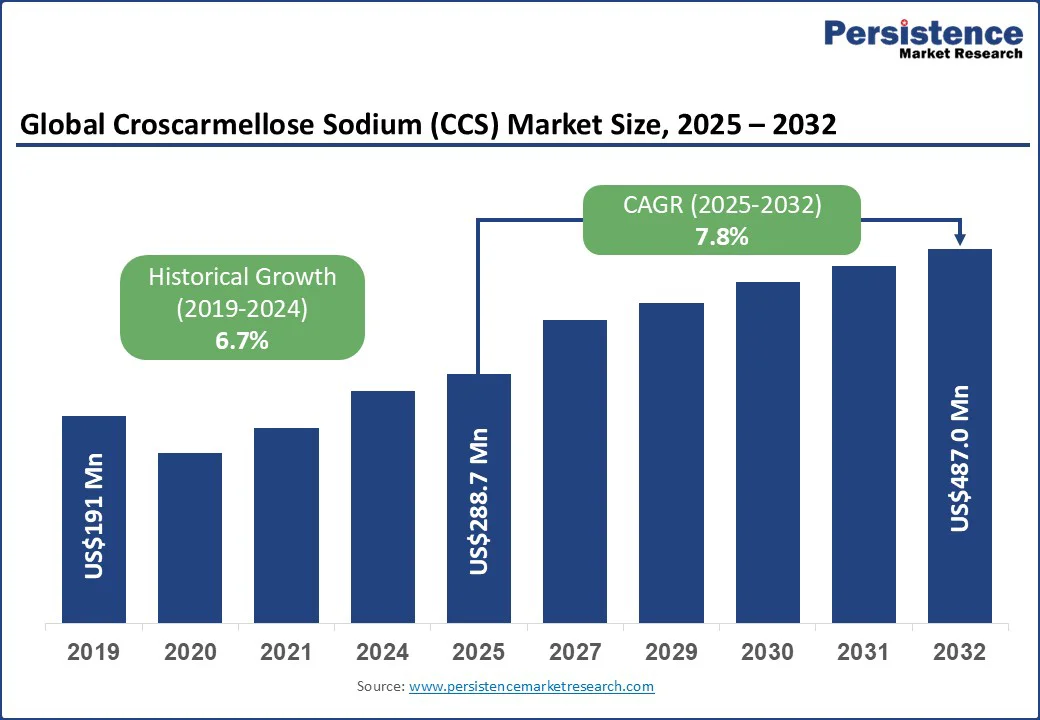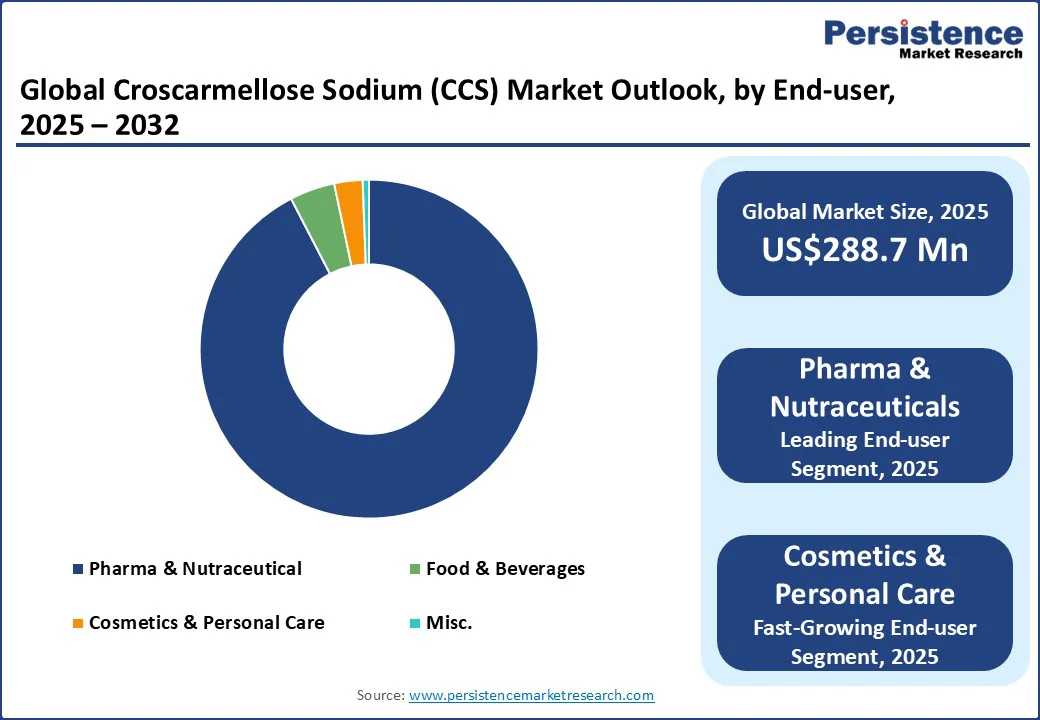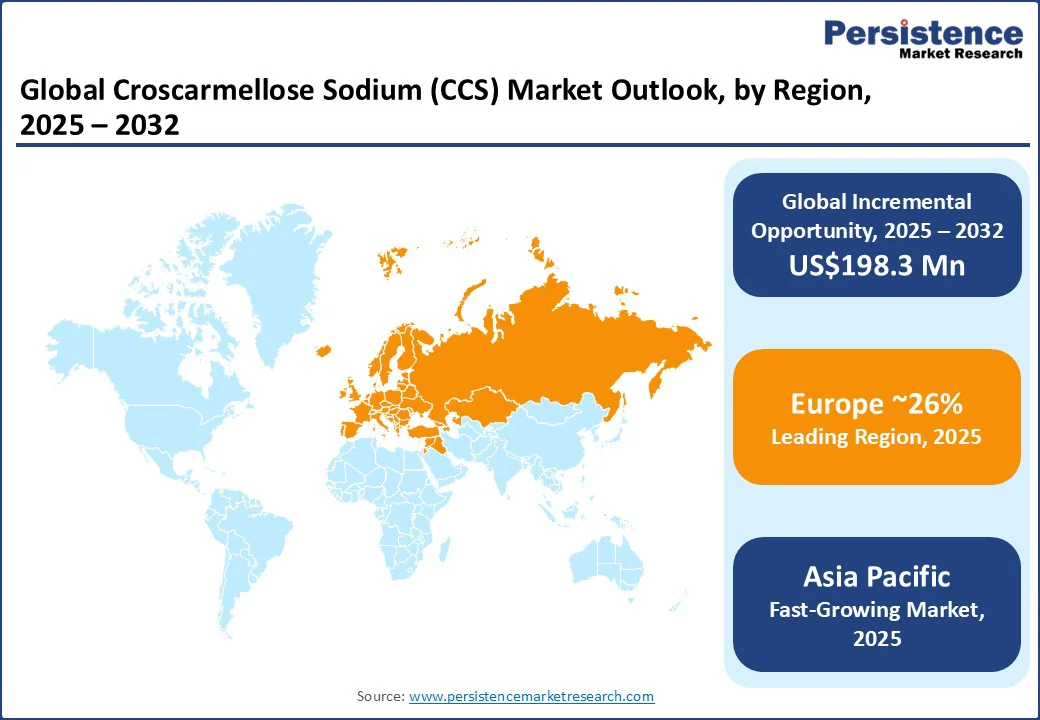ID: PMRREP35640| 194 Pages | 22 Sep 2025 | Format: PDF, Excel, PPT* | Food and Beverages

The global croscarmellose sodium market size is likely to be valued at US$ 288.7 Mn in 2025 and is expected to reach US$ 487.0 Mn by 2032 growing at a CAGR of 7.8% during the forecast period from 2025 to 2032, driven by the rising demand for excipients in the pharmaceutical and nutraceutical industries, where croscarmellose sodium (CCS) plays a vital role as a superdisintegrant in tablets and capsules.
Key Industry Highlights

| Key Insights | Details |
|---|---|
|
Croscarmellose Sodium Market Size (2025E) |
US$288.7 Mn |
|
Market Value Forecast (2032F) |
US$487.0 Mn |
|
Projected Growth (CAGR 2025 to 2032) |
7.8% |
|
Historical Market Growth (CAGR 2019 to 2024) |
6.7% |
One of the key drivers fueling the growth of the croscarmellose sodium market is the rising demand for oral solid dosage and nutraceutical tablets. Tablets continue to dominate drug delivery formats due to their stability, ease of administration, and precise dosing, making them the preferred choice in both pharmaceuticals and nutraceuticals. With the increasing adoption of orally disintegrating tablets (ODTs), the role of superdisintegrants such as croscarmellose sodium has become more critical.
Research highlights that incorporating 0.5–5% croscarmellose sodium can reduce disintegration time from minutes to under 30 seconds, ensuring rapid dissolution and enhanced bioavailability in immediate-release formulations. Its effectiveness at low concentrations, coupled with pharmacopeial recognition and suitability for direct compression and high-dose applications, further boosts its usage. As demand for patient-friendly, fast-acting oral medications grows, croscarmellose sodium is set to witness strong market traction across the pharmaceutical and nutraceutical industries.
A key restraint impacting the global croscarmellose sodium market is the competitive pressure from alternative superdisintegrants such as crospovidone and sodium starch glycolate (SSG). While CCS is a well-established excipient, formulation studies reveal that crospovidone often delivers superior performance, with tablets containing 5% crospovidone achieving faster drug dissolution rates compared to those with equivalent CCS levels. Crospovidone is also associated with lower friability, resulting in stronger tablets that resist breakage during handling and transport.
Similarly, SSG, used at 2–8% concentration, exhibits exceptional swelling capacity, making it a preferred choice for accelerating tablet disintegration. These performance advantages give formulators flexibility to choose alternatives depending on the active pharmaceutical ingredient (API), desired release profile, or cost considerations. As a result, CCS faces reduced exclusivity in pharmaceutical and nutraceutical applications, with manufacturers often weighing cost-effectiveness and mechanical strength against rapid disintegration needs, ultimately restraining the overall growth potential of the croscarmellose sodium market.
An emerging opportunity for the global croscarmellose sodium market lies in its application within premium cosmetics and personal care products. Owing to its cross-linked cellulose structure, CCS exhibits excellent swelling, water-binding, and oil-absorbing properties, making it a valuable ingredient in skincare and cosmetic formulations. These attributes enable enhanced textures, smooth spreadability, and improved sensory profiles in facial powders, while also providing effective sebum control for mattifying and oil-free skincare products.
With the beauty industry increasingly embracing natural, biodegradable, and plant-derived ingredients, CCS stands out as a sustainable alternative to synthetic absorbents and microplastics. Derived from renewable sources like wood pulp and cotton linters, it aligns perfectly with the growing “clean-label” and eco-conscious trends shaping the global cosmetics market. As consumers seek multifunctional and sustainable ingredients, CCS offers formulators a unique blend of performance and environmental responsibility, creating a lucrative growth pathway for croscarmellose sodium beyond its core pharmaceutical applications.
Refined wood pulp dominates the global croscarmellose sodium market, accounting for more than 80% share in 2025, owing to its abundant availability, cost-effectiveness, and high purity levels required in pharmaceutical excipients. Wood pulp provides a consistent cellulose source that undergoes controlled chemical modification to produce cross-linked carboxymethylcellulose, ensuring superior performance in drug formulations.
According to the FAO, global wood pulp production exceeds 190 million metric tons annually, ensuring a reliable supply for excipient manufacturers. Its renewable origin also aligns with sustainability goals in the pharmaceutical and personal care sectors. Refined wood pulp-based CCS demonstrates strong swelling and water-wicking capacity at low concentrations, making it the preferred choice in high-volume oral solid dose formulations.
Pharmaceutical and nutraceutical applications dominate the global croscarmellose sodium market with about 92% revenue share, driven by the overwhelming reliance on oral solid dosage forms. According to the International Journal of Pharmaceutical Sciences, over 70% of medicines worldwide are delivered as tablets or capsules, where superdisintegrants such as CCS are essential to ensure rapid disintegration and bioavailability.
Its inclusion in major pharmacopeias such as the USP, Ph. Eur., BP, and JP highlights its global regulatory acceptance and safety profile. Beyond prescription drugs, CCS is increasingly adopted in nutraceuticals, benefiting from the rapid growth of the US$400+ Bn nutraceutical sector as consumers demand fast-acting, convenient supplements. Its proven functionality, regulatory approval, and adaptability across a wide range of formulations firmly establish pharma and nutraceuticals as the leading end-use segment.

The North America croscarmellose sodium market is strongly influenced by the region’s advanced pharmaceutical and nutraceutical industries. According to the International Federation of Pharmaceutical Manufacturers & Associations (IFPMA), the U.S. accounts for over 40% of global pharmaceutical sales, driving significant demand for CCS in tablets and capsules. Oral solid dosage forms dominate drug delivery in the region, and the growing use of orally disintegrating tablets further supports CCS adoption owing to its rapid disintegration properties. The dietary supplements industry in the U.S. is valued at more than US$60 Bn, which has accelerated CCS usage in nutraceutical formulations. With strong regulatory systems, large-scale generics production, and advanced manufacturing capabilities, North America continues to be one of the most attractive markets for croscarmellose sodium.
The Europe croscarmellose sodium market benefits from a mature pharmaceutical manufacturing base and strict regulatory frameworks. The region holds about 26% of the market share in 2025. Countries such as Germany, Switzerland, and the U.K. are leaders in drug formulation and innovation, which ensures strong excipient demand. Oral solid dosage forms remain the most prescribed drug format across Europe, and CCS is widely recognized under the European Pharmacopoeia (Ph. Eur.) as a reliable superdisintegrant.
According to the European Federation of Associations of Health Product Manufacturers (EHPM), the European nutraceutical market is valued at over €50 Bn (US$53.5 Bn), which is creating significant opportunities for CCS in dietary supplements and functional tablets. Growing consumer awareness of natural and biodegradable excipients derived from renewable sources like wood pulp also supports CCS adoption. The region’s pharmaceutical leadership and sustainability focus continue to drive steady market growth.
The Asia Pacific region is witnessing the fastest growth in the global croscarmellose sodium market because of its rapid pharmaceutical industry expansion and increasing access to healthcare. According to the World Health Organization (WHO), India and China together supply more than 50% of the world’s generic medicines, making CCS indispensable as a superdisintegrant in oral solid dosage forms.
Rising affordability of tablets and capsules, combined with growing nutraceutical consumption in countries such as Japan, South Korea, and India, is contributing to market expansion. The middle-class population across the region is increasing and showing higher demand for dietary supplements, which supports CCS adoption. In addition, governments are strengthening pharmaceutical manufacturing and aligning local production standards with international pharmacopeias. These factors make Asia Pacific a crucial growth engine for the future demand of croscarmellose sodium.

The global croscarmellose sodium market is led by a handful of major players, including Roquette Frères, DFE Pharma, JRS Pharma, IFF Pharma, Accent Microcell Ltd., Mingtai Chemical, and Sigachi Industries.
Collectively, these top five to six companies control around three-fourths of the global market share, underscoring their dominance in both pharmaceutical and nutraceutical applications. Their strong regulatory approvals, international distribution networks, and ability to serve large-scale pharma customers secure their leading positions. The CCS market can be characterized as consolidated, with a small group of leaders driving global volumes and value, while a long tail of niche suppliers serves localized or cost-sensitive markets.
The sroscarmellose sodium market is expected to grow from US$288.7 Mn in 2025 to US$487.0 Mn by 2032, at a CAGR of 7.8%.
Europe leads the croscarmellose sodium market with a 26% share in 2025, driven by strong pharmaceutical hubs, strict Ph. Eur. standards, and a robust nutraceutical industry.
Refined wood pulp dominates CCS production with over 80% share in 2025, owing to its high purity, cost-effectiveness, and renewable availability.
Pharmaceuticals and nutraceuticals account for about 92% of CCS demand, as it is widely used in tablets and capsules for rapid disintegration and better bioavailability.
Croscarmellose sodium is a key excipient that ensures faster disintegration of tablets and capsules, improving drug absorption and therapeutic effectiveness.
The key players include Roquette Frères, DFE Pharma, JRS Pharma, IFF Pharma, Accent Microcell Ltd., Mingtai Chemical, and Sigachi Industries.
| Report Attribute | Details |
|---|---|
|
Historical Data/Actuals |
2019 - 2024 |
|
Forecast Period |
2025 - 2032 |
|
Market Analysis |
Value: US$ Mn |
|
Geographical Coverage |
|
|
Segmental Coverage |
|
|
Competitive Analysis |
|
|
Report Highlights |
|
By Raw Material
By End-user
By Region
Delivery Timelines
For more information on this report and its delivery timelines please get in touch with our sales team.
About Author